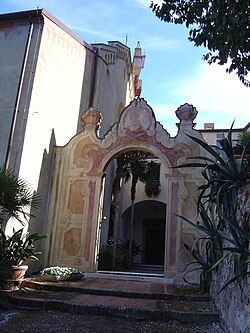Tower of the abbey complex.

Portal of Cervara Abbey.
The Abbey of Cervara (Italian: Abbazia della Cervara or Abbazia di San Gerolamo) is a former abbey in the territory of Santa Margherita Ligure, Liguria, northern Italy, on the coastal road leading to Portofino. It is a national monument of Italy.
History[]
The edifice was built in 1361 by Ottone Lanfranco, a priest in the church of Santo Stefano in Genoa, on a land of the Carthusian monks. It was entitled to St. Jerome.
Later, Pope Eugene IV conceded it to the Benedictines from Monte Cassino (c. 1420), and had it restored. The monastery became a stronghold of the spreading of Flemish culture in Liguria, with works such as the Cervara Polyptych (1506), by Gerard David, and a Adoration of the Magi triptych by Pieter Coecke val Aelst.
The monastery was elevated to the abbey rank in 1546. In the same period it was fortified in reply to the increasing inroads of the North African pirates. In the late 18th century, after the French conquest of Italy, the abbey was suppressed and sacked. The precious Cervara polyptych was split and sold separately. Four panels are now in the gallery of Palazzo Bianco in Genoa,m while the other three are in Metropolitan Museum of Art in New York and the Musée du Louvre in Paris.
In 1804 French Trappists acquired it, but they also went away in 1811. After various passages of property, it is now held privately. In 1912 it was declared a national monument.
The marble decoration is from an 18th-century restoration. The monks' orchard is now replaced by a Renaissance-style Italian garden.
In his history the Cervara Abbey housed several famous people, including Pope Gregory IX, Maximilian of Austria, Saint Catherine of Alexandria and King Francis I of France, who was held here as prisoner in 1525 after his defeat at the Battle of Pavia.

Cervara Abbey.
View of Cervara Abbey.